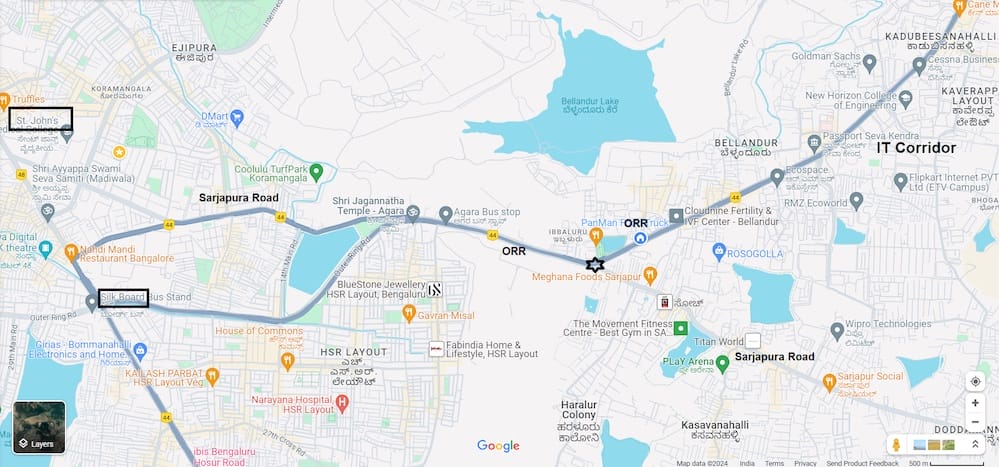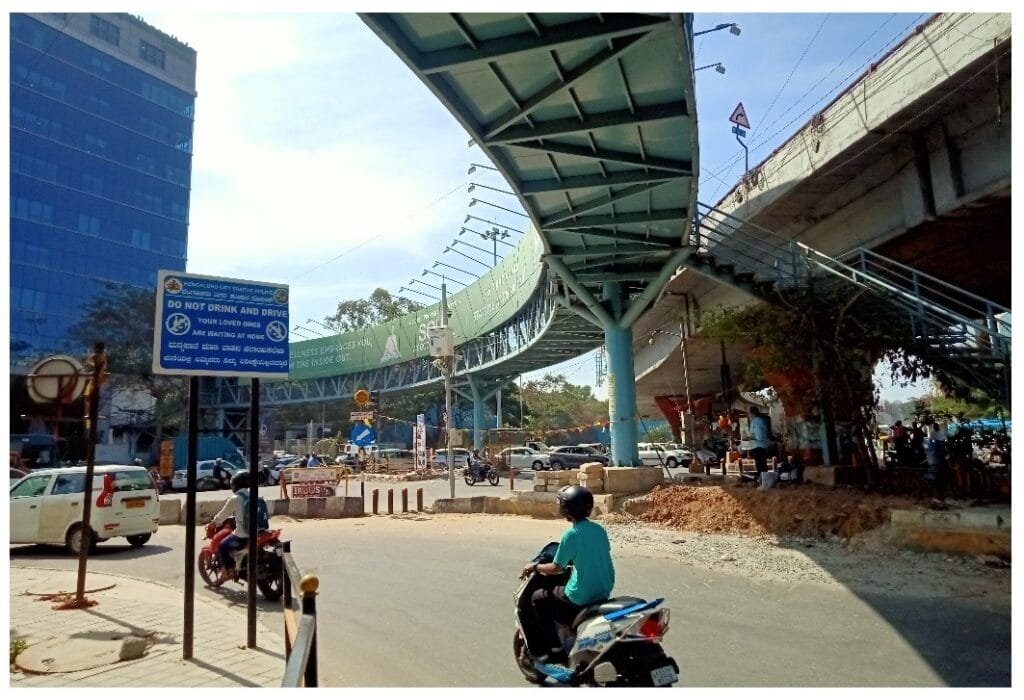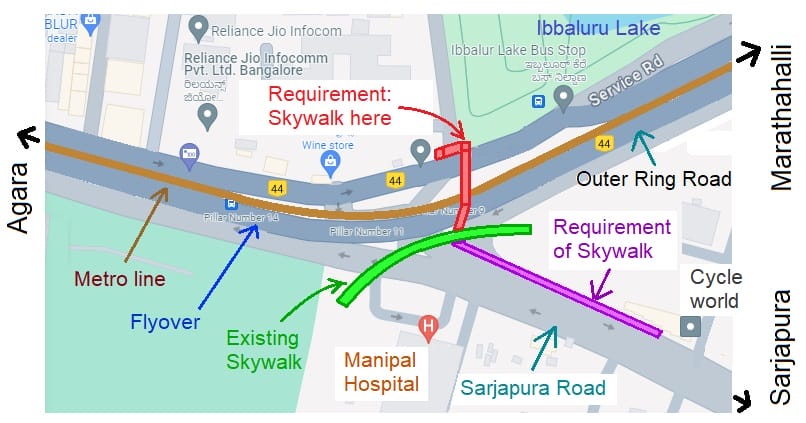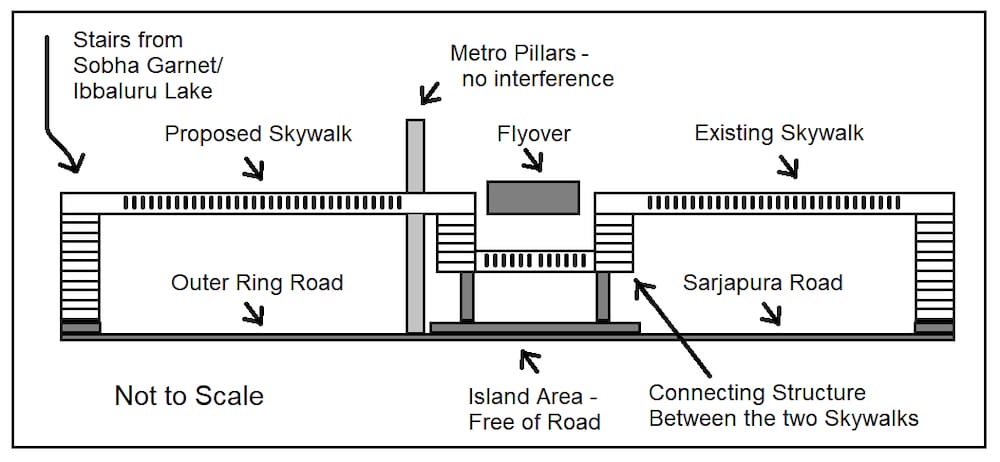Iblur Junction lies at the T-junction of two major roads, Outer Ring Road (ORR) and Sarjapura Road in the IT corridor of south-east Bengaluru. It is a major road intersection, which serves as the gateway to the IT corridor, and lies in close proximity to many important locations in all directions.
However, traffic woes at Iblur Junction are a daily experience. The junction witnesses major traffic congestion, leading bumper-to-bumper traffic.
Caught in the midst of this chaos is the hapless pedestrian, risking life and limb to cross the road and commute daily. Immediate attention from the authorities is required for this situation, as part of the Brand Bengaluru initiative launched by Deputy Chief Minister, DK Shivakumar.
The junction is a major bus interchange and commuters travelling on Sarjapura Road on the 341/342 bus series alight at the junction. They face extreme difficulty in crossing the junction to get to Sarjapura-ORR signal bus stand to board the 500 series buses, which form the backbone of BMTC’s strongest bus network corridor to IT companies.
Current situation
There is a skywalk at the junction, which connects the opposite sides of Sarjapura Road. However, no skywalk connects the two opposite sides of ORR. This is in stark contrast to the large number of pedestrian skywalks in various stretches of ORR. Ironically, despite being a major road junction, the need for pedestrian access is even more critical at this location. Pedestrian deaths have been recorded at this junction during the last few years. One incident occurred near Bellandur Petrol pump, but the memory of such tragic incidents has faded with time.
A nightmare for pedestrians
Residents of the neighbourhood have been actively persisting in their request for a skywalk. Previously, the Bruhat Bengaluru Mahanagara Palike (BBMP) had put up a proposal for constructing a skywalk at Iblur bus stop, which is welcome, but it may be noted that the bus stop is over 300 metres away from the junction. While having a skywalk at Iblur bus stop is necessary, it is not correct to expect that people who need to cross at Iblur junction will have to suffer a long two-way detour to use the skywalk.
Pedestrians on the north side, i.e. on the Iblur lakeside, of ORR find it a great challenge to cross the ORR to reach either the other side of the ORR or Sarjapura Road, and vice versa. The vehicular traffic here is so heavy that there is no slot available for stopping traffic during peak hours. Mostly, they have to depend on the mercy of the traffic police personnel to stop the main ORR traffic from Agara to Bellandur. At other times as well, pedestrians have to wait for a long time before they can cross.
Located at this junction, Manipal Hospital is a large medical facility that caters to the residents in this locality. People who travel by foot to access this facility are seriously inconvenienced by the present scenario. The existing skywalk, from ORR to Sarjapura Road, has practically no users because it does not provide access to the large number of people in the neighbourhood of Iblur Lake.
This junction is a nightmare for pedestrians moving towards Sarjapura Road as there is no pavement on this stretch right up to the point where Bellandur Road joins Sarjapur Road. Even after navigating the wide expanse of traffic to reach Sarjapura Road, pedestrians heading in the direction of Cycle World walk on the edge of the road, which has very high vehicular movement on the one hand and a stinking, often overflowing sewage canal on the other.
In this completely pedestrian-unfriendly scenario, some impatient pedestrians risk crossing the road, against the odds of meeting with an accident that could either maim or kill them.
Apart from injuries to pedestrians, such accidents also lead to traffic jams that take hours to clear and further burden the already stressed traffic police in this area. Therefore, there is a real need to address the issue. Our analysis indicates that a practical solution is possible.
Proposed solution
The existing skywalk, which is currently poorly utilised, could be made more suitable for the needs of pedestrians. In order to make the skywalk truly beneficial for pedestrians, it has to cross ORR, serving both the Iblur lake and Sobha Garnet sides.
In this, there will be one set of stairs from the Iblur lake side and another from the Sobha Garnet side. The latter will join the former and after the merger, the skywalk will go across the ORR to reach the island in the middle. This new section should be linked to the existing skywalk on Sarjapura Road, with a little structural modification.
A study of the area makes it clear that there is space to implement this proposal. Engineering this connectivity is simple and eminently possible.
The existing skywalk should have an extension arm on Sarjapura Road up to the Cycle World point.
Bangalore Metro Rail Corporation Limited (BMRCL) has presently completed the scope of the pillars constructed for the ORR Metro line, and with that, has started releasing sections of the road around the pillars at Iblur junction.
There is currently no restriction at the junction to interfere with any further BMRCL work in the context of the BMRCL ORR Metro line. And while BMRCL has further plans for expansion of the Metro network as part of the Phase 3 Sarjapura Metro line, it may be noted that almost all the design proposals pertain to the ORR, where stretches are already released to the BBMP.
The proposal does not interfere with any existing BBMP structure, including the ORR Iblur uni-directional flyover from Bellandur to Marathahalli, so it presents no risk to existing infrastructure.
The pedestrian crossing simply passes under the flyover. Further, the section of the skywalk to go under the ORR Iblur flyover does not come in the way of any traffic under the junction, for which the mandatory 5.5 metre clearance would be required.
Read more: What it takes to get a skywalk in Bengaluru
Conclusion
The overall cost of this proposal will be limited to that of creating two more links or additions to the existing one. The suggested design does not require bringing down the existing structure, it can simply build on top of that.
If this proposal comes into effect, it will effectively address the woes of pedestrians. It will put an end to the dangers they face in maneuvering these crossings. It will also play a significant role in improving the BMTC connectivity in this location by properly connecting commuters of buses plying on Sarjapura Road and ORR.
This skywalk is long overdue. Residents of the neighbourhood have been expressing their demands ever since the Iblur flyover was conceived 15 years ago. It will bring credence to the Brand Bengaluru initiative and deservingly, put the pedestrian at the top of the commuter priority.
BBMP should attempt to prioritise the requirement. In the event that they are unable to immediately secure funds to execute the proposal, they should, at the very least, provide in-principle approval of the design, which would pave the way for any corporate CSR sponsors to come forward to execute the works.
The solution proposed is ultimately a tactical solution to address the immediate problem of the dangerous pedestrian crossing. However, much like the way Metro systems are designed in many countries, the access to stations must be designed holistically to take the commuter right to the end destination.
It may be conceivable that the proposed stations at Intel, Biocon in Phase 2 may achieve this goal. This pedestrian crossing should ideally be part of a larger commuter mobility initiative that connects Haralur junction, Iblur junction and Iblur Metro/ bus stand as one unified solution.
[Mukund Kumar has also contributed to this article]




We need to think about longer connected sky walks that are senior citizen friendly on both sides of the road which can also be used by cyclists. Think of one from Iblur junction to APR and in the reverse direction with stairs at a distance of 100m to walk down. There could be more like this within walking distance of each other. This way, pedestrians and cyclists will not have to worry about accidents and motorists too will find it easy to move. The need for pedestrian signals will go away. If Mumbai with all its challenges can create 4 km long skywalks, Bangalore surely can.